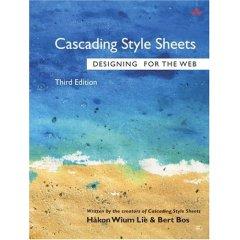| 2020ok Directory of FREE Online Books and FREE eBooks |
Free eBooks > Computers & Internet > Web Development > Internet Commerce > Web Site Design > Cascading Style Sheets: Designing for the Web [CSS]
Cascading Style Sheets: Designing for the Web [CSS]by Håkon Wium Lie  Download Book (Respecting the intellectual property of others is utmost important to us, we make every effort to make sure we only link to legitimate sites, such as those sites owned by authors and publishers. If you have any questions about these links, please contact us.) link 1 About Book Book Description Since 1996, CSS (Cascading Style Sheets) has been the standard language for describing the layout of Web pages. This classic, fully four-color book explains how to use the latest release of the CSS language, with clear and practical examples for each CSS language element. And more than just the "how," the book also explains the "why" behind the design of each CSS element, ensuring that readers have the understanding they need to create their own CSS libraries.The foreward is written by Jeffrey Zeldman, author of Designing with WebStandards and Taking Your Talent to the Web. From the Back Cover In this updated edition to their original best-selling classic, the co-creators of CSS clearly, logically, and painlessly explain the hows and whys and ins and outs of the visual formatting language that is their gift to us. The Web would be a poorer place without Messieurs Bos and Lie. Your shelf will be richer for the addition of this book. Rely on it. Study it. Savor it. The Indispensible CSS Tutorial and Reference—Straight from the Creators of CSS Direct from the creators of CSS, this is the definitive guide to CSS, today's indispensable standard for controlling the appearance of any Web or XML document. This book doesn't just show how to use every significant CSS 1 and 2.x feature; it carefully explains the "why" behind today's most valuable CSS design techniques. You'll find practical, downloadable examples throughout—along with essential browser support information and best practices for building high-impact pages and applications. Cascading Style Sheets: Designing for the Web, Third Edition covers every CSS 2.1 improvement and fix, from new height/width definitions in absolutely positioned elements to new clip property calculations. Clear, readable, and thorough, it's the one must-have CSS resource for every Web developer, designer, and content provider. Coverage includes
© Copyright Pearson Education. All rights reserved. About the Author ABOUT THE AUTHORS HÃ¥KON WIUM LIE is the CTO of Opera Software. His job is to make sure Opera remains a better, smaller, and faster browser than the one you know. Before joining Opera in 1999, HÃ¥kon worked at W3C, where he was responsible for the development of Cascading Style Sheets—a concept he proposed while working at CERN in 1994. HÃ¥kon holds an MS degree in visual studies from the MIT Media Lab. BERT BOS, along with Lie, was one of the original authors of CSS. He joined W3C in 1995 to launch its internationalization activities and currently coordinates its style sheet activities. © Copyright Pearson Education. All rights reserved. Excerpt. © Reprinted by permission. All rights reserved. Since its introduction in 1996, Cascading Style Sheets (CSS) has revolutionized web page design. Now, in 2004, most web pages use CSS, and many designers base their layouts entirely on CSS. To do so successfully requires a good understanding of how CSS works. The purpose of this book is to describe how designers can take full advantage of CSS 2.1, which is the newly released update of the specification. CSS's journey from an idea to a specification–and then on to a specification designers can rely on–has been long and arderous. The creator of the CSS Zen Garden (described in Chapter 12, "From HTML extenstions to CSS") describes it this way: Littering a dark and dreary road lay the past relics of browser-specific tags, incompatible DOMs, and broken CSS support. Today, we must clear the mind of past practices. Web enlightenment has been achieved thanks to the tireless efforts of folk like the W3C, WaSP and the major browser 1 creators. Indeed, we believe the web is a more enlightened place now that CSS have matured to a stage where it can be used for advanced layouts in a range of browsers. This book will tell you all you need to know to start using CSS. Related Free eBooks
| Related Tags |












SEND A COMMENT
PLEASE READ: All comments must be approved before appearing in the thread; time and space constraints prevent all comments from appearing. We will only approve comments that are directly related to the article, use appropriate language and are not attacking the comments of others.